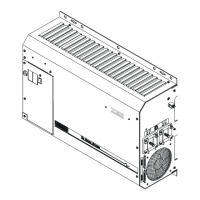OPERATION
Page
66
Copyright Trace Engineering Company, Inc.
5916 - 195th Street N.E.
Arlington, WA 98223
Telephone: 360/435-8826
Fax: 360/435-2229
www.traceengineering.com
PS Series Inverter/Charger
Part No. 3597
Rev. D: November 23, 1999
The following chart provides a guideline in setting the battery charger settings for several different types
of batteries. The battery manufacturer is the best source of information and should be consulted if your
battery type is not shown. Since the settings also depend on the system design, other factors may apply.
Table 6, Charging Setpoints for Common Battery Types
TYPICAL BULK AND FLOAT SETPOINTS FOR COMMON BATTERY TYPES
Battery Type Bulk Volts Float Volts Equalizing Charge Process
Sealed Gel
Lead Acid battery
14.1 VDC BULK 13.6 VDC FLOAT Not Recommended - Consult manufacturer
A.G.M.
Lead Acid battery
14.4 VDC BULK 13.4 VDC FLOAT Charge to 15.5 VDC or as per manufacturer
Maintenance-Free RV/Marine
Lead Calcium Battery
14.4 VDC BULK 13.4 VDC FLOAT Not Recommended - Consult manufacturer
Deep-Cycle, Liquid Electrolyte
Lead Antimony Battery
14.6 VDC BULK 13.4 VDC FLOAT Charge to 15.5 VDC or as per manufacturer
NiCad or NiFe Alkaline Battery*
(using 10 cells in series)
16.0 VDC BULK 14.5 VDC FLOAT Consult manufacturer
Note: Values shown are for 12-volt systems. For 24-volt systems, multiply the settings shown by 2.
These settings are guidelines, refer to your battery manufacturer for specific settings.
EQUALIZING CHARGING BATTERIES
In many of the inverter/charger applications, batteries are subjected to less than ideal operating
conditions. This can result in significant differences in the state-of-charge level between the individual
battery cells. Furthermore, the low charge rates and extended periods at partial charge levels can result
in both stratified battery electrolyte and inactive areas of battery plate material. If the condition is allowed
to remain for extended periods of time, the battery can “sulfate” and become unusable.
To correct this condition, many manufacturers recommend a periodic “equalization” charge to mix up the
electrolyte, re-activate unused battery plate material, and bring up all of the individual cells to a full state
of charge. This requires that the battery be given a controlled “overcharge” by increasing the charge
voltage for a limited period of time. The voltage and time required are both dependent upon the amount of
correction required. The more frequently the batteries are equalized, the lower the equalize voltage and
shorter the time period.
Equalizing a battery is only recommended on unsealed or vented batteries. The process will cause the
electrolyte to gas and will release hydrogen and oxygen in the process. The chance of explosion due to
the accumulation of these gasses is therefore a realistic hazard. The batteries must be provided with
good ventilation with no ignition sources present. Some users have found that the battery cell caps are
subject to clogging during an equalization charge and therefore remove them during this process. Since
the batteries may rapidly bubble while being charged, it is advised that the battery be refilled only after the
equalization process is finished (if the battery electrolyte level is low, add enough to cover the plates
before charging).
The battery manufacturer or supplier should be consulted before equalizing to provide the recommended
process and settings. Every hour the temperature of each battery should be checked by momentarily
feeling the battery case with your hand. If the batteries become excessively warm (too hot to keep your
hand on) during the equalization process, terminate the charging immediately. Let the batteries cool
before checking the need for further equalization charging.

